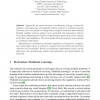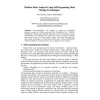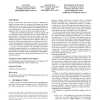171 search results - page 29 / 35 » Environmental design for a structured network learning socie... |
ECAL
2005
Springer
14 years 1 months ago
2005
Springer
Abstract. Inspired by the recent advances in evolutionary biology, we have developed a self-organising, self-adaptable cellular system for multitask learning. The main aim of our p...
ICIP
1998
IEEE
14 years 9 months ago
1998
IEEE
In this work, a framework for the reconstruction of smooth surface shapes from shading images is presented. The method is based on using a backpropagationbased neural network for ...
GI
1998
Springer
13 years 11 months ago
1998
Springer
"KnowledgeMiner" was designed to support the knowledge extraction process on a highly automated level. Implemented are 3 different GMDH-type self-organizing modeling algo...
KDD
2009
ACM
14 years 8 months ago
2009
ACM
In large social networks, nodes (users, entities) are influenced by others for various reasons. For example, the colleagues have strong influence on one's work, while the fri...
BIBM
2008
IEEE
14 years 2 months ago
2008
IEEE
Identifying functionally important sites from biological sequences, formulated as a biological sequence labeling problem, has broad applications ranging from rational drug design ...



